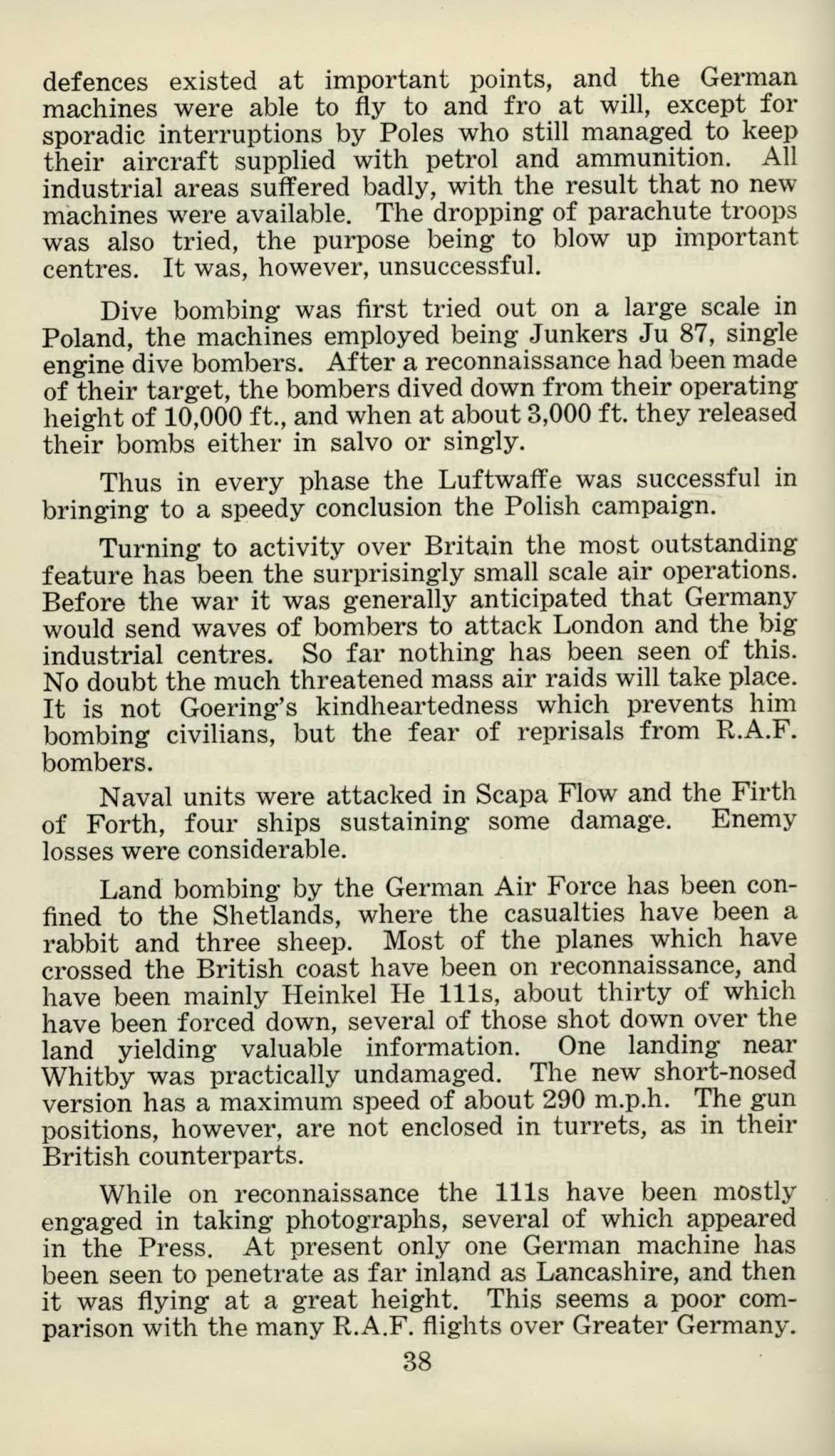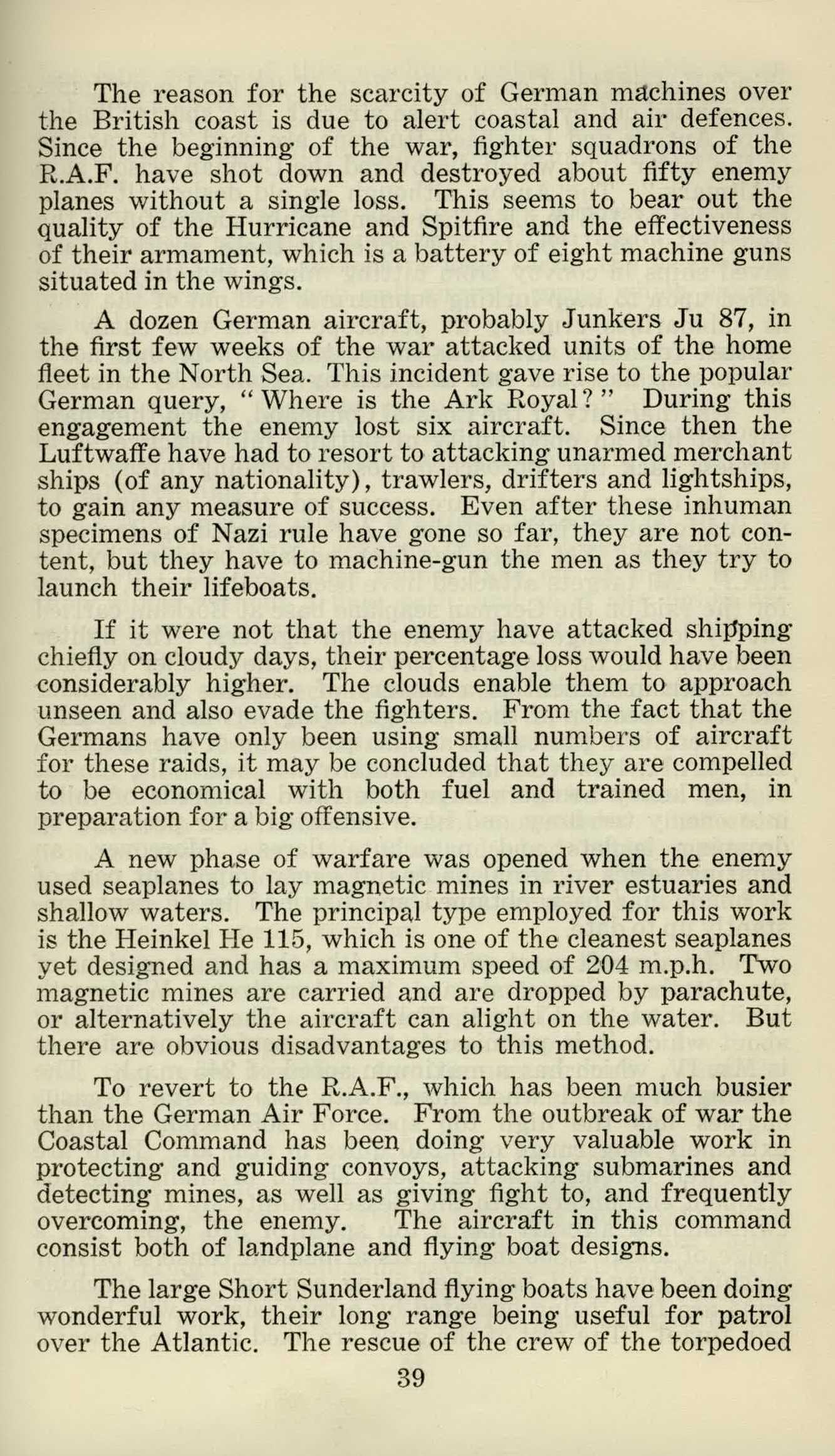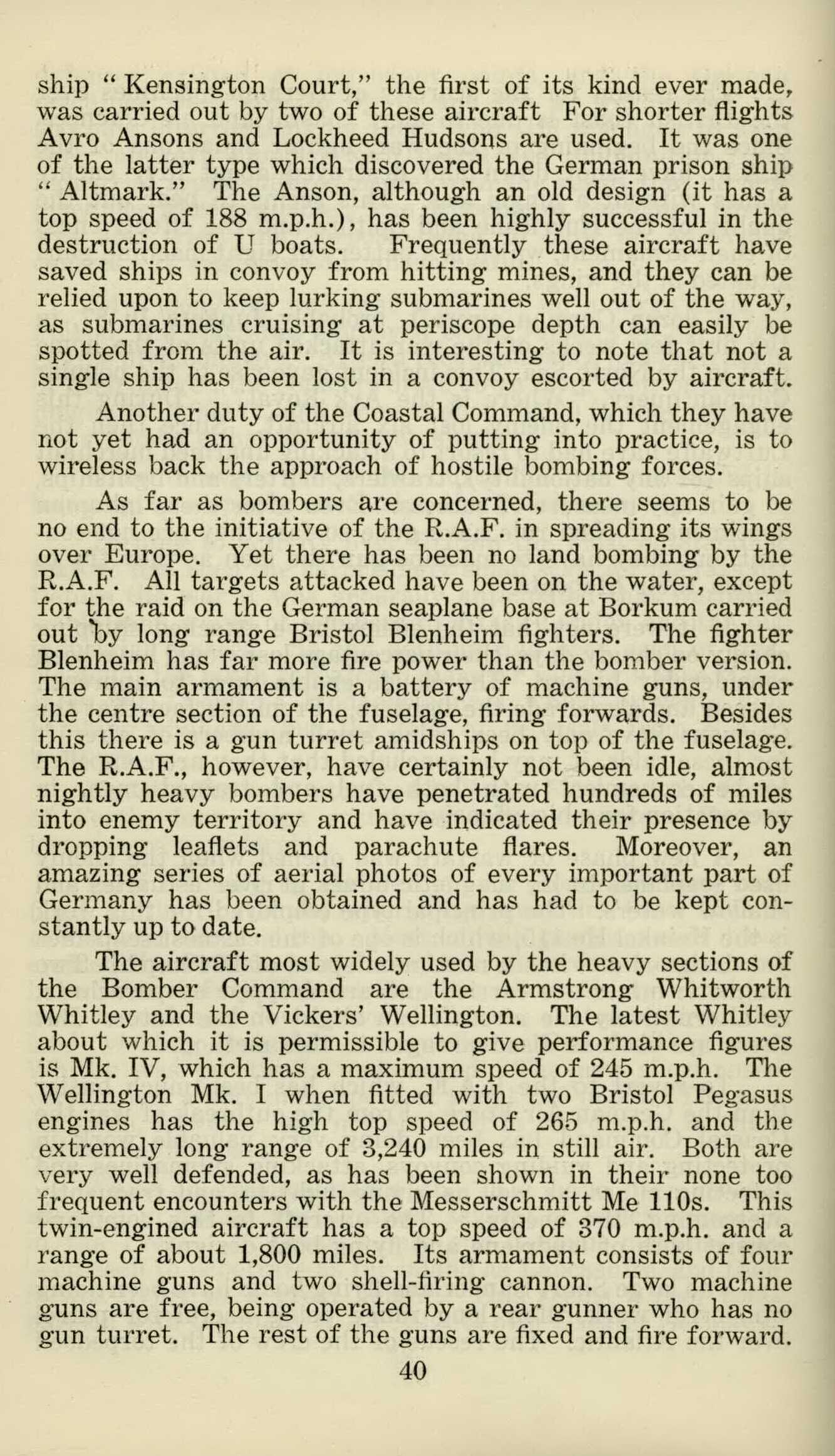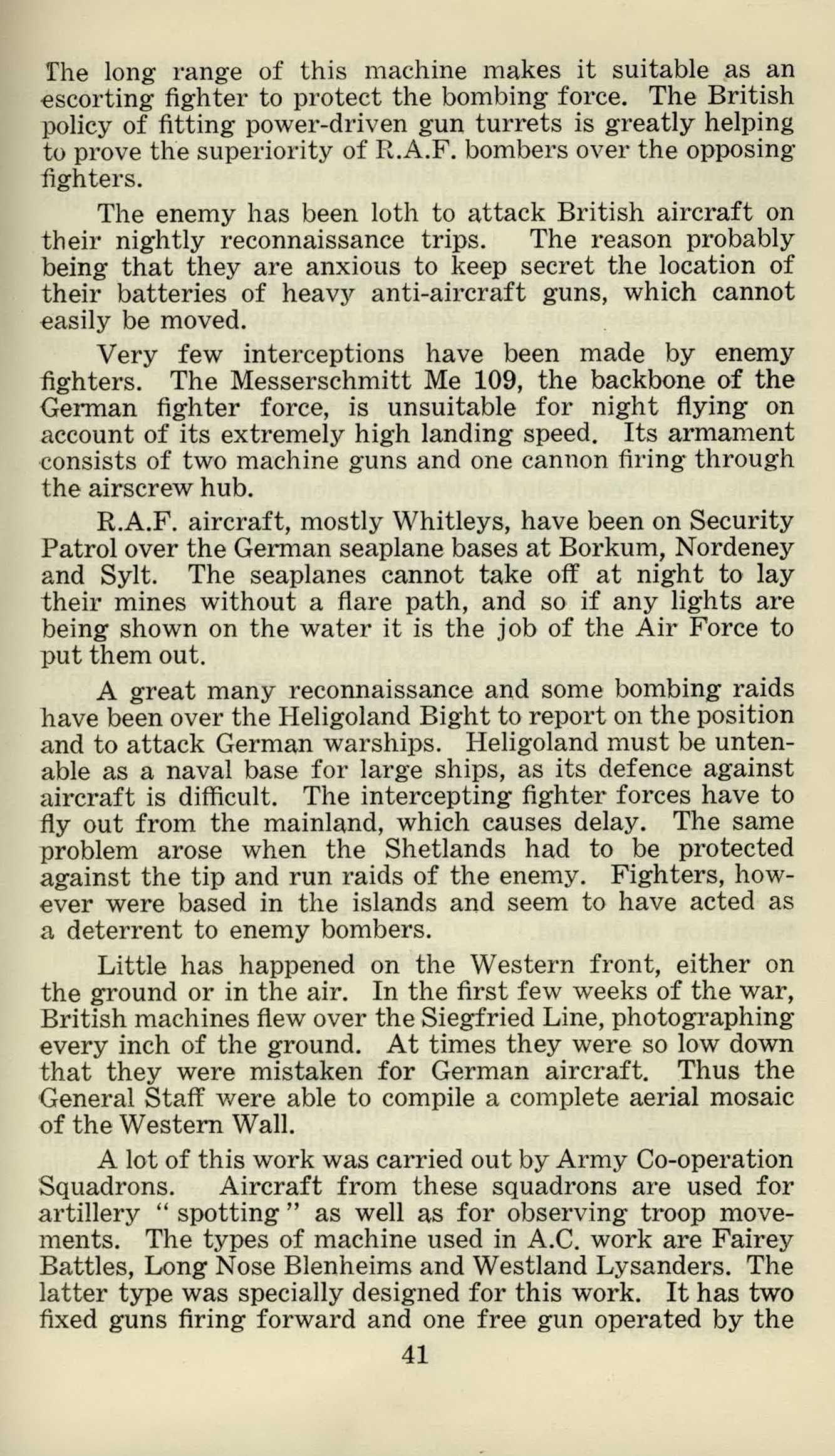
10 minute read
The War in the Air
from April 1940
by StPetersYork
QUESTION IV.
Give one word which means each of the following: (a) " Quot homines, tot sententiae." (b) " Stop." (c) " Form up in a line of sections of three, at the same time forming a close column of platoons and ordering a pint of bitter."
(12 dynes/unit p.)
QUESTION V.
Your C.O. tells you to explain the lying load. You have already explained it six times. What would you say to him ? (Cl. 35.5 ; C, 12 ; 0, 16.)
Note.—Be tactful.
(7/6 in the £.)
QUESTION VI.
What is the field signal for " enemy advancing out of sight in Rolls Royce cars " ?
(dy/dx Cos 0.)
Paul de Kruif.
If it is possible that any good can come out war, then perhaps one rather interesting issue is the fact that the man in the street is becoming increasingly air minded. It is therefore not surprising that the papers are publishing details of air fights with increasing frequency; and thus we hope that anyone who reads this article will not be surprised to see a survey of the war in the air appearing in a school magazine. This survey, which is taken as far as the middle of March, embraces most of the activities of the belligerents in the air war.
The much vaunted " Luftwaffe " had its first experience of warfare in the Polish campaign. The air arm was used to its fullest advantage. Almost before Poland had realised that she was at war, every known Polish aerodrome was raided and at least a fifth of the Polish Air Force wiped out. Then followed a systematic bombing of railheads, junctions, roads and bridges. The Poles fought back heroically, but their machines had to run with no maintenance, and no spares were available. The whole Polish military machine was brought to a standstill. Reserve troops could not reach the front, as the railways were submitted to continual bombing and machine-gunning. Besides this, stationary locomotives were repeatedly attacked by Messerschmitt Me 110s, which used their cannons to perforate the boilers. No anti-aircraft 37
defences existed at important points, and the German machines were able to fly to and fro at will, except for sporadic interruptions by Poles who still managed to keep their aircraft supplied with petrol and ammunition. All industrial areas suffered badly, with the result that no new machines were available. The dropping of parachute troops was also tried, the purpose being to blow up important centres. It was, however, unsuccessful.
Dive bombing was first tried out on a large scale in Poland, the machines employed being Junkers Ju 87, single engine dive bombers. After a reconnaissance had been made of their target, the bombers dived down from their operating height of 10,000 ft., and when at about 3,000 ft. they released their bombs either in salvo or singly.
Thus in every phase the Luftwaffe was successful in bringing to a speedy conclusion the Polish campaign.
Turning to activity over Britain the most outstanding feature has been the surprisingly small scale air operations. Before the war it was generally anticipated that Germany would send waves of bombers to attack London and the big industrial centres. So far nothing has been seen of this. No doubt the much threatened mass air raids will take place. It is not Goering's kindheartedness which prevents him bombing civilians, but the fear of reprisals from R.A.F. bombers.
Naval units were attacked in Scapa Flow and the Firth of Forth, four ships sustaining some damage. Enemy losses were considerable.
Land bombing by the German Air Force has been confined to the Shetlands, where the casualties have been a rabbit and three sheep. Most of the planes which have crossed the British coast have been on reconnaissance, and have been mainly Heinkel He 111s, about thirty of which have been forced down, several of those shot down over the land yielding valuable information. One landing near Whitby was practically undamaged. The new short-nosed version has a maximum speed of about 290 m.p.h. The gun positions, however, are not enclosed in turrets, as in their British counterparts.
While on reconnaissance the 111s have been mostly engaged in taking photographs, several of which appeared in the Press. At present only one German machine has been seen to penetrate as far inland as Lancashire, and then it was flying at a great height. This seems a poor comparison with the many R.A.F. flights over Greater Germany. 38

The reason for the scarcity of German machines over the British coast is due to alert coastal and air defences. Since the beginning of the war, fighter squadrons of the R.A.F. have shot down and destroyed about fifty enemy planes without a single loss. This seems to bear out the quality of the Hurricane and Spitfire and the effectiveness of their armament, which is a battery of eight machine guns situated in the wings.
A dozen German aircraft, probably Junkers Ju 87, in the first few weeks of the war attacked units of the home fleet in the North Sea. This incident gave rise to the popular German query, " Where is the Ark Royal ? " During this engagement the enemy lost six aircraft. Since then the Luftwaffe have had to resort to attacking unarmed merchant ships (of any nationality), trawlers, drifters and lightships, to gain any measure of success. Even after these inhuman specimens of Nazi rule have gone so far, they are not content, but they have to machine-gun the men as they try to launch their lifeboats.
If it were not that the enemy have attacked shipping chiefly on cloudy days, their percentage loss would have been considerably higher. The clouds enable them to approach unseen and also evade the fighters. From the fact that the Germans have only been using small numbers of aircraft for these raids, it may be concluded that they are compelled to be economical with both fuel and trained men, in preparation for a big offensive.
A new phase of warfare was opened when the enemy used seaplanes to lay magnetic mines in river estuaries and shallow waters. The principal type employed for this work is the Heinkel He 115, which is one of the cleanest seaplanes yet designed and has a maximum speed of 204 m.p.h. Two magnetic mines are carried and are dropped by parachute, or alternatively the aircraft can alight on the water. But there are obvious disadvantages to this method.
To revert to the R.A.F., which has been much busier than the German Air Force. From the outbreak of war the Coastal Command has been doing very valuable work in protecting and guiding convoys, attacking submarines and detecting mines, as well as giving fight to, and frequently overcoming, the enemy. The aircraft in this command consist both of landplane and flying boat designs.
The large Short Sunderland flying boats have been doing wonderful work, their long range being useful for patrol over the Atlantic. The rescue of the crew of the torpedoed 39

ship " Kensington Court," the first of its kind ever made, was carried out by two of these aircraft For shorter flights Avro Ansons and Lockheed Hudsons are used. It was one of the latter type which discovered the German prison ship " Altmark." The Anson, although an old design (it has a top speed of 188 m.p.h.), has been highly successful in the destruction of U boats. Frequently these aircraft have saved ships in convoy from hitting mines, and they can be relied upon to keep lurking submarines well out of the way, as submarines cruising at periscope depth can easily be spotted from the air. It is interesting to note that not a single ship has been lost in a convoy escorted by aircraft.
Another duty of the Coastal Command, which they have not yet had an opportunity of putting into practice, is to wireless back the approach of hostile bombing forces.
As far as bombers are concerned, there seems to be no end to the initiative of the R.A.F. in spreading its wings over Europe. Yet there has been no land bombing by the R.A.F. All targets attacked have been on the water, except for the raid on the German seaplane base at Borkum carried out .by long range Bristol Blenheim fighters. The fighter Blenheim has far more fire power than the bomber version. The main armament is a battery of machine guns, under the centre section of the fuselage, firing forwards. Besides this there is a gun turret amidships on top of the fuselage. The R.A.F., however, have certainly not been idle, almost nightly heavy bombers have penetrated hundreds of miles into enemy territory and have indicated their presence by dropping leaflets and parachute flares. Moreover, an amazing series of aerial photos of every important part of Germany has been obtained and has had to be kept constantly up to date.
The aircraft most widely used by the heavy sections of the Bomber Command are the Armstrong Whitworth Whitley and the Vickers' Wellington. The latest Whitley about which it is permissible to give performance figures is Mk. IV, which has a maximum speed of 245 m.p.h. The Wellington Mk. I when fitted with two Bristol Pegasus engines has the high top speed of 265 m.p.h. and the extremely long range of 3,240 miles in still air. Both are very well defended, as has been shown in their none too frequent encounters with the Messerschmitt Me 110s. This twin-engined aircraft has a top speed of 370 m.p.h. and a range of about 1,800 miles. Its armament consists of four machine guns and two shell-firing cannon. Two machine guns are free, being operated by a rear gunner who has no gun turret. The rest of the guns are fixed and fire forward. 40

The long range of this machine makes it suitable as an escorting fighter to protect the bombing force. The British policy of fitting power-driven gun turrets is greatly helping to prove the superiority of R.A.F. bombers over the opposing fighters.
The enemy has been loth to attack British aircraft on their nightly reconnaissance trips. The reason probably being that they are anxious to keep secret the location of their batteries of heavy anti-aircraft guns, which cannot easily be moved.
Very few interceptions have been made by enemy fighters. The Messerschmitt Me 109, the backbone of the German fighter force, is unsuitable for night flying on account of its extremely high landing speed. Its armament consists of two machine guns and one cannon firing through the airscrew hub.
R.A.F. aircraft, mostly Whitleys, have been on Security Patrol over the German seaplane bases at Borkum, Nordeney and Sylt. The seaplanes cannot take off at night to lay their mines without a flare path, and so if any lights are being shown on the water it is the job of the Air Force to put them out.
A great many reconnaissance and some bombing raids have been over the Heligoland Bight to report on the position and to attack German warships. Heligoland must be untenable as a naval base for large ships, as its defence against aircraft is difficult. The intercepting fighter forces have to fly out from the mainland, which causes delay. The same problem arose when the Shetlands had to be protected against the tip and run raids of the enemy. Fighters, however were based in the islands and seem to have acted as a deterrent to enemy bombers.
Little has happened on the Western front, either on the ground or in the air. In the first few weeks of the war, British machines flew over the Siegfried Line, photographing every inch of the ground. At times they were so low down that they were mistaken for German aircraft. Thus the General Staff were able to compile a complete aerial mosaic of the Western Wall.
A lot of this work was carried out by Army Co-operation Squadrons. Aircraft from these squadrons are used for artillery " spotting " as well as for observing troop movements. The types of machine used in A.C. work are Fairey Battles, Long Nose Blenheims and Westland Lysanders. The latter type was specially designed for this work. It has two fixed guns firing forward and one free gun operated by the 41











